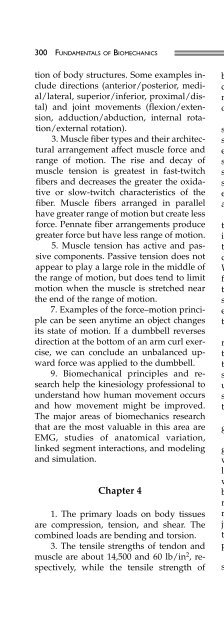Fundamentals of Biomechanics
Fundamentals of Biomechanics
Fundamentals of Biomechanics
You also want an ePaper? Increase the reach of your titles
YUMPU automatically turns print PDFs into web optimized ePapers that Google loves.
300 FUNDAMENTALS OF BIOMECHANICS<br />
tion <strong>of</strong> body structures. Some examples include<br />
directions (anterior/posterior, medial/lateral,<br />
superior/inferior, proximal/distal)<br />
and joint movements (flexion/extension,<br />
adduction/abduction, internal rotation/external<br />
rotation).<br />
3. Muscle fiber types and their architectural<br />
arrangement affect muscle force and<br />
range <strong>of</strong> motion. The rise and decay <strong>of</strong><br />
muscle tension is greatest in fast-twitch<br />
fibers and decreases the greater the oxidative<br />
or slow-twitch characteristics <strong>of</strong> the<br />
fiber. Muscle fibers arranged in parallel<br />
have greater range <strong>of</strong> motion but create less<br />
force. Pennate fiber arrangements produce<br />
greater force but have less range <strong>of</strong> motion.<br />
5. Muscle tension has active and passive<br />
components. Passive tension does not<br />
appear to play a large role in the middle <strong>of</strong><br />
the range <strong>of</strong> motion, but does tend to limit<br />
motion when the muscle is stretched near<br />
the end <strong>of</strong> the range <strong>of</strong> motion.<br />
7. Examples <strong>of</strong> the force–motion principle<br />
can be seen anytime an object changes<br />
its state <strong>of</strong> motion. If a dumbbell reverses<br />
direction at the bottom <strong>of</strong> an arm curl exercise,<br />
we can conclude an unbalanced upward<br />
force was applied to the dumbbell.<br />
9. Biomechanical principles and research<br />
help the kinesiology pr<strong>of</strong>essional to<br />
understand how human movement occurs<br />
and how movement might be improved.<br />
The major areas <strong>of</strong> biomechanics research<br />
that are the most valuable in this area are<br />
EMG, studies <strong>of</strong> anatomical variation,<br />
linked segment interactions, and modeling<br />
and simulation.<br />
Chapter 4<br />
1. The primary loads on body tissues<br />
are compression, tension, and shear. The<br />
combined loads are bending and torsion.<br />
3. The tensile strengths <strong>of</strong> tendon and<br />
muscle are about 14,500 and 60 lb/in 2 , respectively,<br />
while the tensile strength <strong>of</strong><br />
bone is about 18,000 lb/in 2 . These data are<br />
consistent with the higher incidence <strong>of</strong><br />
muscle injuries compared to that for tendon<br />
or bone.<br />
5. The Force–Velocity Relationship has<br />
several implications for resistances and<br />
speed <strong>of</strong> movement in strength-training<br />
exercises. When training for muscular<br />
strength, large resistances should be moved<br />
slowly to train the muscle where it is<br />
strongest. Training for muscular power and<br />
endurance uses smaller resistances moved<br />
at faster speeds.<br />
7. The Force–Time Relationship defines<br />
the delay between neuromuscular signaling<br />
for creation <strong>of</strong> muscle force and a rise in<br />
that force, while the force–time principle<br />
deals with duration <strong>of</strong> force application.<br />
While these two concepts are related, the<br />
force–time principle involves adapting the<br />
timing <strong>of</strong> the application <strong>of</strong> force by a person<br />
to the demands <strong>of</strong> the task while<br />
electromechanical delay is one <strong>of</strong> the factors<br />
that affects how force can be applied.<br />
9. The brain creates muscle tension by<br />
recruitment <strong>of</strong> motor units and modifying<br />
their firing rate or rate coding. Motor units<br />
tend to have predominantly one fiber type,<br />
so that the brain generally recruits motor<br />
units based on the size principle, from<br />
slow-twitch motor units to fast-twitch motor<br />
units.<br />
11. Muscle spindles sense stretch and<br />
golgi tendon organs sense muscle tension.<br />
13. Large ranges <strong>of</strong> motion allow for<br />
greater production <strong>of</strong> speed and force,<br />
while smaller ranges <strong>of</strong> motion tend to allow<br />
for more accurate movement. The<br />
weight shifts in a golf swing and baseball<br />
batting are small because <strong>of</strong> the high accuracy<br />
demands <strong>of</strong> these skills. Maximizing<br />
range <strong>of</strong> motion in the countermovement in<br />
jumps is not usually effective because <strong>of</strong><br />
timing limitations or biomechanically weak<br />
positions in deep knee flexion.<br />
15. A person doing a seated knee extension<br />
exercise uses concentric action <strong>of</strong> the






